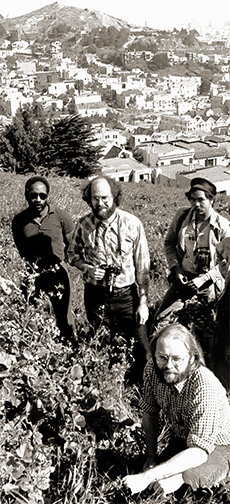
Images From a High Point Early in the 50-Year History of the San Francisco Study Center
Fifty years ago, the Study Center opened to offer technical assistance to the evolving grassroots groups sprouting in San Francisco neighborhoods. We combined journalism and community organizing, explaining city government’s nuts and bolts and giving resident-led organizations the tools to assemble their own piece of the civic pie.

Some Oral History Project staff gather on Bernal Hill: from left, C. Malcolm Thompson, Bill Carlson, Lenny Limjoco and, in the foreground, Study Center Executive Director Geoff Link.
It was the ’70s and the city was in transition. Italians were exiting North Beach with Chinatown taking up the slack. Urban renewal had driven Black families to Bayview and out of town. The gay migration was well under way. Manilatown vanished when the I-Hotel was demolished. Irish and Russian families were deserting the vast Sunset and Richmond neighborhoods and fleeing to the suburbs. The Mission District was changing from Chicano to Latino. And so it went.
San Francisco Study Center was a catalyst amid the changes, among the pioneering technical assistance nonprofits: Accountants for the Public Interest, Childcare Switchboard, the Management Center, Social Services Directory and countless others.
Our monthly “San Francisco Newsletter” was the first periodical to cover Board of Supervisors committee meetings, not just the full board, and to regularly report on the City Planning, Public Works and Building Inspection departments and others in the city bureaucracy. Our breakthrough “Understanding San Francisco’s Budget” publication explained how city money was allocated and when the groups should get in line for their fair share.
CETA — the early 1970s federal Comprehensive Education and Training Act — was a perfect fit for Study Center’s work. With our six-figure grant, we hired a corps of interviewers and photographers to conduct an Oral History of San Francisco Neighborhoods Project that produced a trove of taped interviews and a collection of extraordinary, many now-historic, photographs.
In the 1977-78 project, we interviewed interesting residents of specific neighborhoods and photographed them in settings of their choice, in or outside their homes or workplaces. Photographers Lenny Limjoco, Bill Carlson, Wayne Redus and C. Malcolm Thompson also covered neighborhood street fairs, historic moments at City Hall and images that captured the city’s moods. Limjoco, who continued on as Study Center’s staff photographer and graphic designer, died in 2012, and Bill Carlson passed away May 11, 2022. His sister sent Study Center a 2005 self-published book of his photographs, which inspired this historical display of a high point early in our half-century history.
